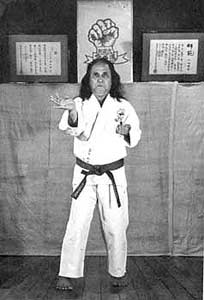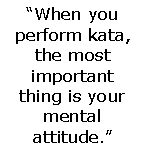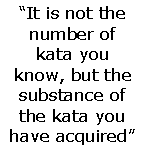Goju-Ryu Karate-Do Kyohan
The Significance of Kata
by Yamaguchi Gogen "The Cat"
Editor's note: This article is the second in a three
part series excerpted from Yamaguschi's classic karate text, "Goju
Ryu Karate Do Kyohan: The History and Fundamentals of Goju-Ryu Karate,"
now in reprint. The first article was "The
History and Fundamentals of Goju-Ryu Karate," and
the third article is "Practice
Fighting."
Before You Start Kata
Today, karate-do has become widespread not only in Japan but also all
over the world and competitions are held in many places.  Most
of them are title matches by a game of kumite. For that reason, the purpose
of practice is to win the competition; therefore, most of the players
emphasize practicing kumite. They do not practice kata as much as is needed.
I think this is because karate has spread internationally by turning to
competition, like other sports, instead of the unification of each karate
ryu-ha. I feel that this is very unfortunate. Most
of them are title matches by a game of kumite. For that reason, the purpose
of practice is to win the competition; therefore, most of the players
emphasize practicing kumite. They do not practice kata as much as is needed.
I think this is because karate has spread internationally by turning to
competition, like other sports, instead of the unification of each karate
ryu-ha. I feel that this is very unfortunate.
While learning karate from the late Miyagi Chojun Shihan when I was a
student, it was Okinawan karate itself. Therefore, all the practices were
basics and kata training; the practice of kata was very strict. I had
to express the fruit of effort by basics training in kata. After that,
I reformed many techniques that are used in kata for kumite and when I
started to practice jiyu kumite, I could confirm that the Goju-ryu kata
are very theoretical for the actual fight.
 Kata
is the attitude of self-defense that you perform with a presumed attack
in mind as well as your defense on a fixed embu-line (the line of movement
of the kata), to protect yourself from a hypothetical enemy with your
body that is trained well by strict practice. Which means you structure
the attack from the hypothetical enemy with a meaningful and effective
counterattack systematically. You perform individually with the interpretation
based defense and on that theory. Moreover, the purpose of Goju-ryu kata
is not only the practice of techniques but also the training of the body
(or gathering your internal thoughts), as a result, you can say that kata
is the "expression of yourself when you learn karate-do." Kata
is the attitude of self-defense that you perform with a presumed attack
in mind as well as your defense on a fixed embu-line (the line of movement
of the kata), to protect yourself from a hypothetical enemy with your
body that is trained well by strict practice. Which means you structure
the attack from the hypothetical enemy with a meaningful and effective
counterattack systematically. You perform individually with the interpretation
based defense and on that theory. Moreover, the purpose of Goju-ryu kata
is not only the practice of techniques but also the training of the body
(or gathering your internal thoughts), as a result, you can say that kata
is the "expression of yourself when you learn karate-do."
You can learn kata wherever and whenever you want. Anyone, old or young,
men or women can learn at their own pace. Especially girls and boys. Not
only can children learn the real meaning of self-defense, which is the
original purpose of kata, but it can also be one of the methods to train
their body. Still, the structure of the acts of kata has the elements
of symmetry and balance so that the value of it (aesthetic expression
of body form) can be obtained.
-
Kata is composed of these elements:
-
The manner of Rei (bow)
-
The direction of embu-line (pattern of movement)
-
The combinations of techniques
-
The uses of attack, defense and postures
-
The strength and the speed of techniques
-
Kiai (shout) and Kihaku (projecting the spirit)
-
Gathering one's thoughts
-
The strength and speed as whole kata
-
Introduction, development, turn and conclusion
-
How to breathe (Ikibuki)
-
The time of embu (kata performance)
The Origin Of Kata
 When
karate-do was called te (meaning "hand") in Okinawa, there was
neither an organization nor a ryu-ha (an organized style passed down over
time) at that time. The practice of te had been accomplished secretly
in Naha and Shuri (districts which divide Okinawa in two). The practice
was very strict. It was not like the practice you do in a team at the
dojo, which most people do now. The practice was done headed by a teacher
with a few students, or one-on-one training. The place was sometimes in
a room floored with tatami mats (traditional rectangular Japanese straw
floor mats), sometimes in a field or on the beach. Training was always
done in a natural environment while hiding from others and in secret.
For that reason, there were no textbooks to hand down dealing with kata.
It was instructed by the ancients, body to body so that the origins of
many kata are unknown. When
karate-do was called te (meaning "hand") in Okinawa, there was
neither an organization nor a ryu-ha (an organized style passed down over
time) at that time. The practice of te had been accomplished secretly
in Naha and Shuri (districts which divide Okinawa in two). The practice
was very strict. It was not like the practice you do in a team at the
dojo, which most people do now. The practice was done headed by a teacher
with a few students, or one-on-one training. The place was sometimes in
a room floored with tatami mats (traditional rectangular Japanese straw
floor mats), sometimes in a field or on the beach. Training was always
done in a natural environment while hiding from others and in secret.
For that reason, there were no textbooks to hand down dealing with kata.
It was instructed by the ancients, body to body so that the origins of
many kata are unknown.
 Currently,
there are 60 types of kata from Naha and Shuri; however, because the origins
of Naha-te and Shuri-te are different, the names and the way they are
done show a big difference. The person who systematically structured kata
for Naha-te is Higaonna Kanryo Shihan (master teacher), who was the shihan
of Mr. Miyagi Chojun. For Shuri-te, it was Matsumura Soshu Shihan. As
I explained in, "The History of Karate-do," Higaonna Kanryo
Shihan went to Fukuken-sho in China and learned Chinese kempo. He put
Naha-te and Chinese kempo together and created the basic form of Sanchin
and Tensho. Ikibuki was invented by Miyagi Chojun Shihan, who inherited
the style from Higaonna Kanryo Shihan. When the breathing method was taken
into kata, the kata were improved. After that, the kata Gekisai numbers
1 and 2 were created to spread the kata of Goju-ryu. Currently,
there are 60 types of kata from Naha and Shuri; however, because the origins
of Naha-te and Shuri-te are different, the names and the way they are
done show a big difference. The person who systematically structured kata
for Naha-te is Higaonna Kanryo Shihan (master teacher), who was the shihan
of Mr. Miyagi Chojun. For Shuri-te, it was Matsumura Soshu Shihan. As
I explained in, "The History of Karate-do," Higaonna Kanryo
Shihan went to Fukuken-sho in China and learned Chinese kempo. He put
Naha-te and Chinese kempo together and created the basic form of Sanchin
and Tensho. Ikibuki was invented by Miyagi Chojun Shihan, who inherited
the style from Higaonna Kanryo Shihan. When the breathing method was taken
into kata, the kata were improved. After that, the kata Gekisai numbers
1 and 2 were created to spread the kata of Goju-ryu.
Chinese names are used for Goju-ryu kata because both Higaonna and Miyagi
Chojun Shihan learned Chinese kempo in China. Presently, the names of
kata are written in katakana (one of three Japanese syllabaries), however,
in this book, Sanchin and Tensho are written in kanji (characters).
About Embu-Line
An embu-line is the fixed direction and angles of the body when you perform
kata or when you attack, defend, and turn the body. There are eight basic
directions: front and back, left and right, oblique of front, back, left,
and right. For performing kata, embu-line has to be structured in these
eight directions in a fixed order and you have to perform the prescribed
technique from a prescribed standing position on this line. Each kata
has a different embu-line.
The Method Of Practice And Points To Pay Attention
When you perform kata, the most important thing is your mental attitude.
Kata is not a play. You have to perform it seriously. It is easy to remember
the order of kata, but the essence is not only to have performed the kata,
but how you acted. For that reason, you have to practice the basics, such
as the standing position, how to defend, how to thrust, and how to kick
every day.
When you remember the order of kata, you have to practice the used techniques
in kata individually and repeatedly, then you can connect the techniques
you practice. When you are able to do this basic practice, you have to
think of the technique as kata and not the individual techniques. You
have to pay attention to how long it takes, strength, and speed, so that
you can move and turn the body without waste.
The embu-line is fixed. You start from the starting point and come back
to the starting point. One way to practice is to put a mark on the starting
point when you act. When dan [black-belt level] grades perform, individuality
appears in kata, but it is better not to develop an extreme habit.
 There
is no end to the practice of kata. Even though a person who has a high
dan performs, the acts are never perfect. The practice is unlimited because
kata is for improving yourself mentally and physically. Yet the performance
has to be improved in different ways with each step as a beginner, whether
you have kyu [colored belt level] or dan (black belt level), although
you are performing the same kata. Knowing a difficult kata does not mean
you have a high dan. In some foreign countries, sometimes they evaluate
a person by the number of kata they know. I believe that it is not the
number of kata you know, but the substance of the kata you have acquired. There
is no end to the practice of kata. Even though a person who has a high
dan performs, the acts are never perfect. The practice is unlimited because
kata is for improving yourself mentally and physically. Yet the performance
has to be improved in different ways with each step as a beginner, whether
you have kyu [colored belt level] or dan (black belt level), although
you are performing the same kata. Knowing a difficult kata does not mean
you have a high dan. In some foreign countries, sometimes they evaluate
a person by the number of kata they know. I believe that it is not the
number of kata you know, but the substance of the kata you have acquired.
The important things are:
-
How to bow
-
The posture
-
The placement of the eyes
-
Kiai (shout), kihaku (projection of spirit)
When you perform kata without an opponent, you feel like there is no
meaning in the technique so that the fist of seiken-tsuki (basic straight
punch) or the tightness of the standing position can be loosened. You
should not think that you are doing the attack or the defense by yourself;
you always have to think that you are defending against an attacker.
And of course last, the secret of improving kata is to repeat the practice
since just the theory will not help.
Gorei of Kata -- From Rei to Hajime
Usually you do kata by the gorei [commands] of a person who has a higher
kyu or dan than you. There are two ways to gorei: One is to gorei in the
beginning and the end. The other is to gorei each technique, by numbers.
Especially, the latter is used for practice of Fukyu-gata (it will be
explained later). It is used when you practice with many people, such
as beginners. However, in principle, the practices of techniques are done
without gorei. All the practice of kata is done by starting the gorei
of "rei" (bow), "mokuso" (close your eyes to clear
your mind), the name of the kata, "yoi," (prepare commend) and
"hajime" (begin the kata) by a leader. If there is no leader,
you try to gorei in your mind by yourself.
Rei, Standing at Attention
Stand in musubi-dachi (heels together, open toe stance) and put your
hands down with the fingers straight. The thumbs have to be bent from
the second joints inside. This is the posture of kiotsuke (attention).
You have to release the power of the body. You bend the upper part of
the body by the gorei (command) of "rei" (bow) by a leader.
The eyes have to be staring at the floor two meters in front of you .
"Mokuso" is for calming your mind and gathering your thoughts
before you perform. You stand straight and close your eyes lightly. Mokuso
is different each time. The leader will call gorei and the name of the
kata when he judges the performer's mind is calm. (Usually it takes three
breaths, or about ten seconds, to be calm.)
When the leader calls "yoi," (prepare) you have to cross both
hands in front of your body while you breathe in; and then, while you
are breathing out, bring both fists to your sides as if you are tightening
your belt, then tighten both armpits like you are pushing at the floor
with your fists and put power in your whole body. You open both heels
to the outside and when you breath out, bring them to heiko-dachi (parallel
stance). This posture has another name, jinno-dachi. It is the posture
before you get in ready posture (kamae). All the muscles of your body
have to be tensed. The placement of your eyes is a little bit higher than
the height of the eyes.
The reason you cross both hands in front of your body is to cover the
groin area from a sudden attack; at the same time, you show the opponent
that you will not attack suddenly. As in the etiquette of the samurai
in which they take off a katana (sword) from the waist and change it to
the right hand showing that no cowardly act, such as slashing the opponent
without notice, will occur. From that meaning, the inside of the hand
that is crossed has to be your dominant arm.
The points to pay attention to when you are in yoi posture:
-
Do not put the power on the shoulders.
-
Pull in your chin and put power in the abdominal muscles; however,
do not be stooped.
-
Straighten your back but do not stick out the abdomen.
Part 1: The
History and Fundamentals of Goju-Ryu Karate
Part 3: Practice
Fighting
This excerpt from Yamaguchi's book, "Goju Ryu Karate Do Kyohan,"
was submitted by Masters Publications. This is the fourth book in the
Limited Edition series translated from Japanese into English and published
by Masters Publication; the first was "To-Te Jitsu" by Funakoshi
Gichin, followed by "Okinawan Kempo" by Motobu Choki and "Wado
Ryu Karate" by Otsuka Hiroki.
For more information contact:
Mastersline/Rising Sun Video Productions
310-477-7604 fx 310-383-3135
http://www.masterspub-mas.com/
Email: donrw@earthlink.net
|